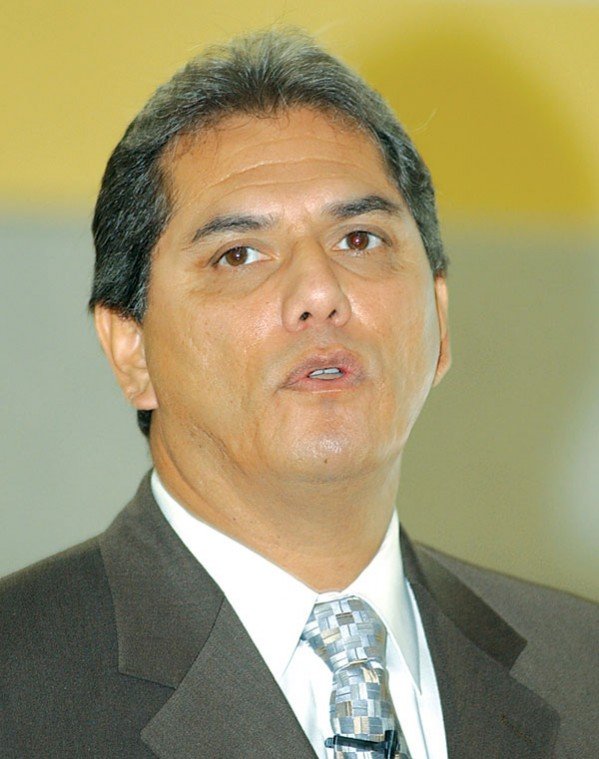Gilroy
– Edwin Diaz is asking for everyone’s help – not just the school
district’s 900 employees, but the city’s business owners, parents,
and students.
Saying that the school district is facing some very real
challenges this year, from low test scores to budget cuts, Diaz,
the superintendent of schools, is asking all district employees to
rally around his improvement plan and include the community in
their effort.
By Lori Stuenkel
Gilroy – Edwin Diaz is asking for everyone’s help – not just the school district’s 900 employees, but the city’s business owners, parents, and students.
Saying that the school district is facing some very real challenges this year, from low test scores to budget cuts, Diaz, the superintendent of schools, is asking all district employees to rally around his improvement plan and include the community in their effort.
Diaz delivered his fourth state of the schools address Wednesday morning, and welcomed all Gilroy Unified School District staff to the start of a new year. His half-hour speech outlined some of the steps he and GUSD employees will be taking to meet upcoming challenges and increase student achievement.
“This is a new opportunity to do what we do better, to support the children who go to our schools,” said Diaz to hundreds of teachers, principals, bus drivers, secretaries and food service workers gathered in the Ascencion Solorsano Middle School gym. “But there are new challenges. …
“I think we have the right staff and I think we have the right steps in place to meet these challenges.”
Diaz was joined by Douglas Reeves, a leading performance assessment expert, who later in the morning highlighted the three “R”s of student achievement: Resourceful, Relentless and Resilient.
The goals for the district are laid out in the Strategic Plan, revised this spring:
– All students will continuously improve their academic achievement
– All students will be proficient in reading, writing and math
– The achievement gap will be eliminated
The means for getting there, Diaz said, will come from the Accountability Plan, still in its formative stages. GUSD is re-grouping after falling short of its previous Strategic Plan, which sought to have 90 percent of students proficient in reading, writing and math.
“I feel good about it,” Diaz said in an interview Wednesday afternoon. “I feel that this plan is very thoughtful, in that these long-term goals address issues in the district, that all kids achieve and that all kids benefit from instructional improvement efforts.
“What’s happened in the past is that, as a district, we not only set the goals but we also told the schools how to reach those goals.”
That’s where the Accountability Plan comes into play, which gives schools flexibility in setting specific goals to match what they want to see happen district-wide.
“That’s the piece that has to happen well for this to have an impact on student performance,” Diaz said Wednesday afternoon. “With anything that is this comprehensive and this bold, really you always worry about how it will be implemented, but at this point, I’m feeling really confident.”
With Gilroy public schools starting classes Monday, there was a relaxed and positive vibe to Wednesday’s gathering of GUSD employees, who clapped intermittently at Diaz’s statements or jokes from Reeves.
Test Scores
The most rousing round of applause and cheers was one of frustration from GUSD teachers.
“In some ways, I think we’ve gone overboard with these types of summative measures,” Diaz said, of some standardized tests given throughout the year. The audience immediately cheered its approval.
“Would you agree with that?” he quipped after the clapping died down.
Student test scores, released by the state last week, are arguably the most pressing of three major challenges that face educators and other district employees, Diaz said.
“We’ve had some good growth at different schools; we’ve had some drops in certain areas; but this is the first year that we’ve had to say that we are struggling to increase the performance of our students,” he said. “There is a lot of work to be done in that area and it will be a challenge for all of us.”
Under the new Accountability Plan, schools won’t use “benchmark” tests as often.
“There’s a shift … to using more frequent ongoing assessments that will give us information on an ongoing basis in relation to the standards,” Diaz said.
Schools will choose other, shorter and more frequent assessments that will give more valuable and immediate feedback.
“I think what’s very clear here is that in order to take the next step and reach the district’s goals and continue that improvement, schools need appropriate flexibility,” Diaz said.
Reeves – the assessment expert who spoke after Diaz, complements of the Stupski Foundation that has supported GUSD’s improvement efforts – likened the need for teacher feedback to that of a football coach out on the field. For example, say a player fails to catch an important pass.
“Do you pull out your grade book and write down, ‘Receiving … C-?’ ” Reeves asked a coach in the audience. “No. You give him immediate feedback on his performance.”
Outside Scrutiny
A second issue for the coming year that could compound with the challenge of raising test scores is scrutiny from outside the district, Diaz said.
The community’s spotlight on the GUSD is often cited by educators as causing undue stress.
“The challenge for us is to be able to reach out and be able to use the constructive feedback we get from the community,” he said.
One example of the way that’s already been done is the Strategic Planning process, he said, which included input from more than 900 district employees, parents, community members and students.
“There is a tremendous amount of good will in our community,” he said. “Going through this process, I realized there are a lot of people in our community who want to give back.”
Budget Cuts
The final challenge Diaz addressed Wednesday morning is the prospect of another round of budget cuts.
Tight finances – specifically an expected $900,000 shortfall by 2005-06 – also will once again cloud the district’s operations.
“For the third year in a row, we’ve had to decrease expenditures,” Diaz said.
All district departments will need to look at expenditures and ask whether they really support district priorities, he said.
For instance, workers compensation has become an excessive expense, at $1.8 million for this year’s premium. Other districts, Diaz said, are paying half that.
The overriding goals of the Strategic Plan are within reach, Diaz said, echoing a mantra from the plan: All means all, including staff, parents, community and business members.
“What I really realized is that the work is so great and the challenge is so great that it takes everyone to really concentrate with and support kids in order to make significant improvements.”













